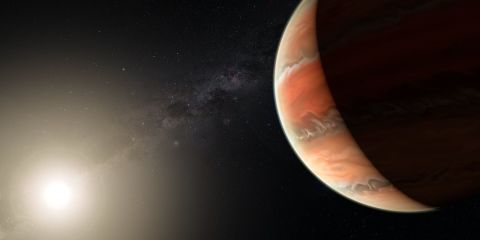The planet is 13 times the size of Jupiter, so large it's almost big enough to become a star.
Scientists have discovered thousands of exoplanets—planets orbiting other stars—in the last few years, but pretty much all of them have been spotted in our galactic backyard. All of the planets discovered by the Kepler spacecraft, for instance, are within a few thousand light-years of our own sun, which is practically next door on a galactic scale. There's a whole galaxy, about 100,000 light-years across, filled with exoplanets for us to find, and we've yet to make it outside our cosmic neighborhood.
That's why a recent announcement from the Korea Astronomy and Space Science Institute is so exciting: they've discovered an exoplanet that appears to be inside the galactic bulge. The bulge is the central core of our galaxy where most of the stars reside, but it's also a chaotic place that's not very hospitable to planets. If our sun fell into the bulge, the planets in our solar system would likely be ripped away by other stars pretty quickly.
But this new planet discovered by the researchers isn't an ordinary exoplanet. The planet, named OGLE-2016-BLG-1190Lb, is over 13 times bigger than Jupiter, and is as big as a planet can possibly be before it triggers nuclear fusion reactions and ignites into a star. In fact, it's so close to the boundary that there's a chance OGLE-2016-BLG-1190Lb is really a brown dwarf star instead of a planet.
The researchers discovered the planet using the Spitzer Space Telescope and the Polish Optical Gravitational Lensing Experiment (OGLE). Gravitational lensing, or microlensing, occurs when a massive object, in this case a star, passes in front of another star. The foreground star's gravity magnifies the light of the star in the background, and if there is a planet orbiting the closer star, astronomers can detect its presence by measuring the light of the magnified star behind. The size and mass of the planet can be measured based on how much light is blocked and for how long.
Of course, microlensing requires a distant star for the planet to block, which can be a slow and inefficient way to search for exoplanets. Researchers have only found a handful of planets using microlensing, but astronomers can use the technique to find the most distant worlds we know of, like OGLE-2016-BLG-1190Lb. This newest discovery is not only one of the largest planets ever discovered, it's also one of the farthest away, which means that we can expect future discoveries of giant, distant worlds by Spitzer and other telescopes.
Who knows what strange worlds we've yet to discover.
Source: Phys.org
Bagikan Berita Ini
















0 Response to "Astronomers Find Enormous Planet In the Galaxy's Core"
Post a Comment